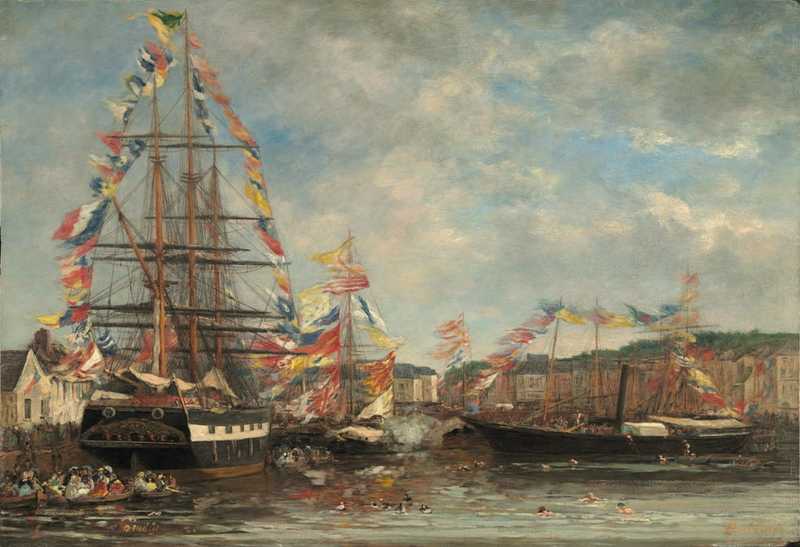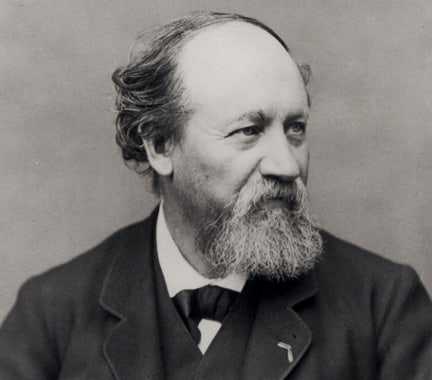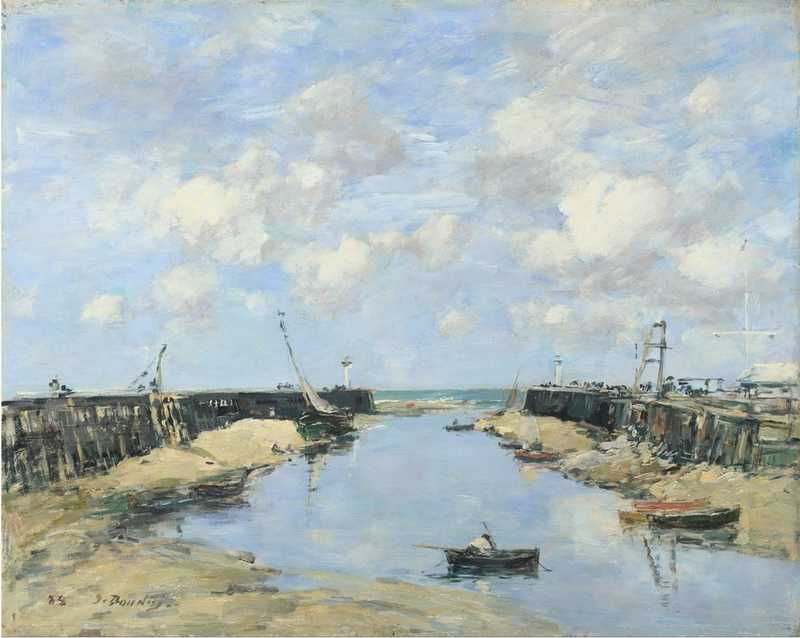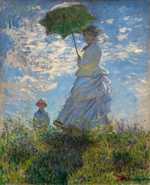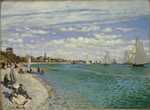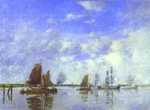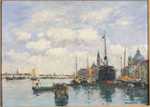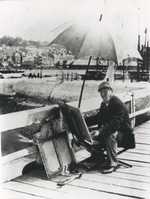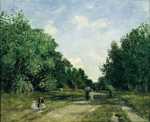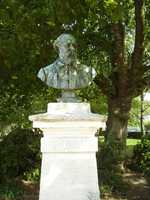1. Early Years
Boudin was born in Honfleur, Normandy in 1824 to Marie-Félicité Buffet and Léonard-Sébastien Boudin, a sailor.
During his childhood years he helped his father working on one of the first steamships, a ferry that ran between Honfleur and Le Havre, a large port on the English Channel.
Eventually, the family moved to Le Havre and the scenes around this coastal city became the subject of much of Boudin’s work.
Boudin's family
After leaving the seafaring industry, Boudin’s father established a framing and stationary shop in Le Havre where his son worked before co-owning his own shop.
It was here that he met a range of influential artists and painters, including Thomas Couture and Jean-François Millet. Both Couture and Millet encouraged and inspired Boudin to begin painting himself.
The Barbizons
In 1846, Boudin left the framing shop and moved to Paris to pursue his artistic career, first studying at the Louvre.
Whilst in Paris, Boudin was introduced to the Barbizon school, a group of painters based around the village of Barbizon which included Charles-François Daubigny, Théodore Rousseau, Narcisse-Virgilio Diaz de la Peña and Jean-François Millet.
Boudin also met Jean-Baptiste-Camille Corot who was to become a great inspiration in the young artist’s work. These artists painted the surrounding landscape, especially inspired by the Forest of Fontainebleau.
They were some of the first painters in France to begin working outside, making them highly influential to the Impressionist movement to come.
2. Eugène Boudin and the Impressionists
Boudin returned to Le Havre in 1853 where he painted pictures of the coastline in the region where he had grown up.
Drawing on his seamanship experience, he made notes on the back of his paintings including the time of day, light levels, wind and weather conditions.
Flags and festivals
In his 1858 painting ‘Festival in the Harbour of Honfleur’, Boudin captures the movement of wind in the fabric of the colourful flags adorning the ships. He smudged the wispy edges to create a blurred effect which is instantly recognisable as a fresh, windy day on the sea. The painting depicts a joyous, celebratory scene with figures swimming in the water and a cloudy but bright sky.
Moody blues
This work is in stark contrast to his paintings of stormier weather such as ‘Gust of Wind at Frascati, Le Havre’, painted in 1896, which displays a dark sky represented in greys overlaying dark blues. Tempestuous waves are shown crashing against the shore threatening to engulf buildings and people.
The sea is painted in shades of green and almost looks as though it is moving on the canvas while a white lighthouse provides a striking detail against the darkness of the clouds. A red flag blows violently in the wind above the figures struggling on the shore. In this painting Boudin distilled the essence of being by the sea in stormy weather, an experience he knew well.
Jongkind and en plein air
Dutch artist Johan Barthold Jongkind, a friend of Boudin, was the first person to encourage him to begin painting outside. Specialising in landscapes, Jongkind used elements of traditional Dutch landscape painting in his work while also pioneering techniques that would become foundational to the Impressionist movement.
Like Boudin, he painted the Normandy coast. He also painted scenes from the River Seine in Paris and the Dutch canals.
Painting outdoors was of huge significance to the work of a landscape artist like Boudin. He was once quoted as saying:
“everything that is painted directly and on the spot has always a strength, a power, a vivacity of touch which one cannot recover in the studio.”
The plein air method allowed artists to capture the feel of a landscape as they experienced it rather than trying to replicate the specific details of a place from sketches and from memory.
Standing on Constable's shoulders
The en plein air method was first experimented with by British painter John Constable in 1813 before being adopted by the impressionists around 1860.
In the 1870s, the production of tube paints made painting outside much easier, as artists now had access to ready-made paints rather than having to mix their own using linseed oil combined with coloured powder. Along with portable easels, paints in tubes made outdoor painting accessible for any artist and became a popular method particularly with the impressionists.
The use of light ...
Painting en plein air naturally led to a shift in the use of light in paintings as landscape artists became aware of and interested in the endless variations of light conditions and how they influence a scene.
From morning dew to the evening golden hour, as well as the way light changes with the seasons, it is little wonder that the study of light was of vital importance to the Impressionist movement once they began painting en plein air.
... and capturing the sky
A prominent feature of Boudin’s work was his focus on capturing the sky. He often used two thirds of a painting to show the clouds, colours and light of the sky.
Ever changing, the movement of the clouds and the variations in light served as a source of huge inspiration to his work. In his 1888 painting The Entrance to Trouville Harbour over half of the painting is dedicated to the expansive sky, light blue with white clouds. The sky is also reflected in the water of the harbour, which stretches all the way to the edge of the painting, enclosed by the sandy banks. By devoting so much of this painting to the sky, Boudin’s perspective makes the viewer feel as though they are in the scene, looking out to sea from the harbour.
Boudin was nick-named ‘King of the Skies’ by Jean-Baptiste-Camille Corot. Corot was a landscape artist who, like Boudin, was hugely influential to the Impressionists, especially with his use of light on landscapes. Corot created oil sketches directly from nature but unlike Boudin, his paintings were finished in the studio.
Interestingly, his landscape sketches created outside became as important as his paintings finished inside thanks to their spontaneity. Much like Boudin, he also helped to pave the way for Impressionist landscapists looking to escape from the strict rules of academic art.
3. Eugène Boudin and Claude Monet
Perhaps Boudin’s biggest influence on the Impressionists was his relationship with Claude Monet. Boudin encouraged his friend, who also grew up on the Normandy coast near Le Havre, to paint outside with him. Unbeknownst to them both, this was a pivotal moment for the Impressionist movement.
Before he met Boudin, Monet had been selling charcoal caricatures; however, his friend saw more potential in the young artist. He invited Monet to join him in painting the sea at Honfleur saying “I want you to see the light.” After he was introduced to painting en plein air, Monet went on to spend the next 60 years creating new ways to immortalise the impression of landscapes in his work.
Boudin’s influence can be seen throughout Monet’s work for example in his painting ‘Woman with a Parasol - Madame Monet and Her Son’ painted in 1875. The painting shows a woman and child on a sunny, windy day. In a similar style to Boudin’s work, Monet captured the impression of wind in the movement of the fabric and flowers in the piece, as well as with the clouds. The woman’s shadow is long and takes up most of the foreground indicating where the light falls. The sky also takes up a large portion of the painting, which was typical of Boudin’s style.
Boudin and Monet painted beaches and seascapes not to provide a precise and accurate representation of the scene but rather to capture the feeling or impression of that moment in time, the atmosphere of a landscape rather than the detail in the features of a place. This was enhanced by the method of finishing a painting in the open air as none of the moment was lost in translation between the subject of the painting and the studio, it was recorded exactly as it was, full of movement and life. In the work of both artists we find paintings of vast landscapes where details such as buildings, people and boats are often added almost as an afterthought to enhance to the overall scene, rather than depicted with precision.
Painting together on the Normandy coast, Boudin and Monet shared subjects and often painted the same landscape, each in their own style. However, it is clear to see Monet echoing what he had learnt from his older friend. Monet’s 1867 painting ‘Regatta at Sainte-Adresse’ and Boudin’s ‘The Meuse at Dordrecht’ painted in 1882 both depict boats on the water at Le Havre on a sunny, calm day. Both artists have focused on capturing the sky and the sea. Monet used green brushstrokes in the foreground to add depth and texture to the sea closer to the shore whilst Boudin painted the reflections of the boats and clouds on water.
While there are no figures on the beach in Boudin’s painting, he chose to add more detail to the ships than in Monet’s painting. Monet’s painting depicts people sitting by the water along with a few buildings in the distance. However, as is typical of both artists' work, more attention has been paid to the surroundings, namely the sky and the sea, than the small details. Both paintings give the impression of a bright sunny day at Le Havre.
4. Later career
Boudin received recognition for his work much later in his career than one might expect given how well his paintings sold. His most popular works were beach scenes painted on the Normandy coast.
In contrast to his usual landscape paintings, the scenes of the beach resorts of Trouville and Deauville focussed on the tourists who flocked to the crowded beaches of the coastline as the leisure industry in this region grew
This gave Boudin the opportunity to paint not just the landscapes but to capture the social aspect of the beach culture, depicting the fashionable attire against his signature expansive skies.
‘La Plage de Trouville’ painted in 1864 is a great example of this work. Figures in brightly coloured clothing are shown crowding together on the beach, some sitting on chairs whilst others play in the water. The gay scene is set against the backdrop of a cloudless blue summer sky.
In 1874, his work was displayed in the First Impressionist exhibition alongside Monet’s paintings and from 1875 Boudin’s paintings were exhibited in the official Salon. Boudin decided not to join the Impressionist movement with Monet, a decision which perhaps cost him the lasting recognition he deserved.
Instead, the painter opted to try and win the favour and approval of academics and officials in the French artistic establishment. He had some success in this endeavour, winning a prize at the Paris Salon in 1881 and a gold medal at the Exposition Universelle in 1889. In 1892, Boudin was granted the honour of becoming a knight of the Légion d'honneur, the highest decoration in France for both military and civil merit, created by Napoleon Bonaparte in the early 1800s.
During his later life, Boudin began spending the winter months in the South of France to allow him to continue painting outside thanks to the warmer weather. In 1892, he also began travelling regularly to Venice and in 1895 he created seventy-five pieces of art including both paintings and sketches to capture the city. In ‘Venice, The Grand Canal’ painted in 1895, we see Boudin’s signature style in the sky and the reflection of the boats on the water. The vigorous brushstrokes in the piece, despite providing very little detail, evoke a strong sense of the atmosphere of the place.
Boudin wrote to art dealer Paul Durand-Ruel the same year saying: “I am busy painting views of Venice, a superb town as I have no need to tell you, but I am somewhat disgusted by the usual painters of the area who have to some extent disfigured it by making it appear as a region warmed by the hottest sun [...] Venice on the other hand, like all luminous regions, is grey in colour, the atmosphere is soft and misty and the sky is decked with clouds just like over Normandy or Holland.”
Boudin continued painting for as long as he was able and he is reported to have said to his friend, Braquaval, in 1896 “my trip to Venice will have been my swansong”. He died in 1898 at the age of seventy-four at his home in Deauville on the Normandy coast.
5. Legacy
It is somewhat surprising how little is known about Boudin in popular culture, especially considering his influence on the art of Impressionism.
His legacy is most notable in the work of Monet who once said, “If I have become a painter, I owe this to Eugène Boudin and no other.”
There are relatively few exhibitions of his work today as most of Boudin’s paintings have been sold individually to private collectors. The largest collection of his work is currently held in the Eugène-Boudin Museum in Honfleur, France.
Despite his relative lack of fame in the Impressionist movement, Boudin’s influence is far reaching, particularly in his use of light, his focus on skies in a landscape and his method of painting outdoors. The humble artist said of himself “I may well have had some small measure of influence on the movement that led painters to study actual daylight and express the changing aspects of the sky with the utmost sincerity.” He did not know how impactful his work would be on the Impressionist era and later movements to come.


